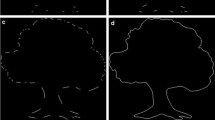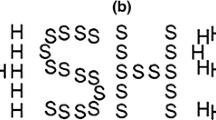Abstract
Autism spectrum disorders (ASD) are characterised by a unique pattern of preserved abilities and deficits within and across cognitive domains. The Complex Information Processing Theory proposes this pattern reflects an altered capacity to respond to cognitive demands. This study compared how complexity induced by time constraints on processing affect cognitive function in individuals with ASD and typically-developing individuals. On a visual information-processing task, the Subtle Cognitive Impairment Test, both groups exhibited sensitivity to time-constraints. Further, 65 % of individuals with ASD demonstrated deficits in processing efficiency, possibly attributable to the effects of age and clinical comorbidities, like attention deficit hyperactivity disorder. These findings suggest that for some ASD individuals there are significant impairments in processing efficiency, which may have implications for education and interventions.




Similar content being viewed by others
References
American Psychiatric Association. (2000). Diagnostic and statistical manual of mental disorders: DSM-IV-TR (4th revised ed.). Washington DC: American Psychiatric Association.
American Psychiatric Association. (2013). Diagnostic and statistical manual of mental disorders (5th ed.). Arlington, VA: American Psychiatric Publishing.
Ames, C., & White, S. (2011). Brief report: Are ADHD traits dissociable from the autistic profile? Links between cognition and behaviour. Journal of Autism and Developmental Disorders, 41(3), 357–363. doi:10.1007/s10803-010-1049-0.
Anderson, M. (2001). Annotation: Conceptions of intelligence. Journal of Child Psychology and Psychiatry and Allied Disciplines, 42, 287–298. doi:10.1017/S0021963001007016.
Ashwin, E., Ashwin, C., Rhydderch, D., Howells, J., & Baron-Cohen, S. (2009). Eagle-eyed visual acuity: An experimental investigation of enhanced perception in autism. Biological Psychiatry, 65(1), 17–21. doi:10.1016/j.biopsych.2008.06.012.
Baddeley, A. (2012). Working memory: Theories, models, and controversies. Annual Review of Psychology, 63(1), 1–29. doi:10.1146/annurev-psych-120710-100422.
Bertone, A., Mottron, L., Jelenic, P., & Faubert, J. (2005). Enhanced and diminished visuo-spatial information processing in autism depends on stimulus complexity. Brain, 128(10), 2430–2441. doi:10.1093/brain/awh561.
Bruce, K., Yelland, G., Almeida, A., Smith, J., & Robinson, S. (2014). Effects on cognition of conventional and robotically-assisted cardiac valve surgery. Annals of Thoracic Surgery, 97(1), 48–55. doi:10.1016/j.athoracsur.2013.07.018.
Bruce, K., Yelland, G., Smith, J., & Robinson, S. (2013). Recovery of cognitive function after coronary artery bypass graft surgery. Annals of Thoracic Surgery, 95(4), 1306–1313. doi:10.1016/j.athoracsur.2012.11.021.
Caron, M.-J., Mottron, L., Berthiaume, C., & Dawson, M. (2006). Cognitive mechanisms, specificity and neural underpinnings of visuospatial peaks in autism. Brain, 129(7), 1789–1802. doi:10.1093/brain/awl072.
Charman, T., Jones, C., Pickles, A., Simonoff, E., Baird, G., & Happé, F. (2011). Defining the cognitive phenotype of autism. Brain Research, 1380, 10–21. doi:10.1016/j.brainres.2010.10.075.
Connors, C. (1997). Conners rating scales (Revised). North Tona-wanda, NY: Multi-Health Systems.
Corbett, B., Constantine, L., Hendren, R., Rocke, D., & Ozonoff, S. (2009). Examining executive functioning in children with autism spectrum disorder, attention deficit hyperactivity disorder and typical development. Psychiatry Research, 166(2–3), 210–222. doi:10.1016/j.psychres.2008.02.005.
Derakshan, N., & Eysenck, M. (2009). Anxiety, processing efficiency, and cognitive performance. New developments from attentional control theory. European Psychologist, 14(2), 168–176. doi:10.1027/1016-9040.14.2.168.
Dickerson Mayes, S., & Calhoun, S. (2007). Learning, attention, writing, and processing speed in typical children and children with ADHD, autism, anxiety, depression, and oppositional-defiant disorder. Child Neuropsychology: A Journal on Normal and Abnormal Development in Childhood and Adolescence, 13(6), 469–493. doi:10.1080/09297040601112773.
Dickerson Mayes, S., Calhoun, S., Mayes, R., & Molitoris, S. (2012). Autism and ADHD: Overlapping and discriminating symptoms. Research in Autism Spectrum Disorders, 6(1), 277–285. doi:10.1016/j.rasd.2011.05.009.
Eagle, R., Romanczyk, R., & Lenzenweger, M. (2010). Classification of children with autism spectrum disorders: A finite mixture modeling approach to heterogeneity. Research in Autism Spectrum Disorders, 4(4), 772–781. doi:10.1016/j.rasd.2010.02.001.
Einfeld, S., & Tonge, B. (1992). Manual for the Developmental Behaviour Checklist. Clayton, Melbourne and Sydney: Monash University for Developmental Psychiatry and School of Psychiatry, University of New South Wales.
Einfeld, S., & Tonge, B. (1995). The developmental behavior checklist: The development and validation of an instrument to assess behavioral and emotional disturbance in children and adolescents with mental retardation. Journal of Autism and Developmental Disorders, 25(2), 81–104. doi:10.1007/BF02178498.
Einfeld, S., & Tonge, B. (2002). Manual for the developmental behaviour checklist: primary carer version (DBC-P) and teacher version (DBC-T) (2nd ed.). Clayton, Melbourne: Monash University Centre for Developmental Psychiatry and Psychology.
Eysenck, M., & Calvo, M. (1992). Anxiety and performance: The processing efficiency theory. Cognition and Emotion, 6(6), 409–434. doi:10.1080/02699939208409696.
Eysenck, M., Derakshan, N., Santos, R., & Calvo, M. (2007). Anxiety and cognitive performance: Attentional control theory. Emotion, 7(2), 336–353. doi:10.1037/1528-3542.7.2.336.
Forster, K. (1999). The microgenesis of priming effects in lexical access. Brain and Language, 68(1–2), 5–15. doi:10.1006/brln.1999.2078.
Forster, K., & Davis, C. (1984). Masked priming and frequency attenuation in lexical access. Journal of Experimental Psychology. Learning, Memory, and Cognition, 10(4), 680–698. doi:10.1037/0278-7393.10.4.680.
Forster, K., & Forster, J. (2003). DMDX: A windows display program with millisecond accuracy. Behavior Research Methods, Instruments & Computers, 35(1), 116–124. doi:10.3758/BF03195503.
Friedman, T., Robinson, S., & Yelland, G. (2011). Impaired perceptual judgment at low blood alcohol concentrations. Alcohol, 45(7), 711–718. doi:10.1016/j.alcohol.2010.10.007.
Friedman, T., Yelland, G., & Robinson, S. (2012). Subtle cognitive impairment in elders with Mini-Mental State Examination scores within the ‘normal’ range. International Journal of Geriatric Psychiatry, 27(5), 463–471. doi:10.1002/gps.2736.
Hill, E., & Bird, C. (2006). Executive processes in Asperger syndrome: Patterns of performance in a multiple case series. Neuropsychologia, 44, 2822–2835. doi:10.1016/j.neuropsychologia.2006.06.007.
Holdnack, J., Goldstein, G., & Drozdick, L. (2011). Social perception and WAIS-IV performance in adolescents and adults diagnosed with Asperger’s syndrome and autism. Assessment, 18(2), 192–200. doi:10.1177/1073191110394771.
Huemer, S., & Mann, V. (2010). A comprehensive profile of decoding and comprehension in autism spectrum disorders. Journal of Autism and Developmental Disorders, 40(4), 485–493. doi:10.1007/s10803-009-0892-3.
Kalff, A., De Sonneville, L., Kalff, A., Hurks, P., Hendriksen, J., Kroes, M., et al. (2005). Speed, speed variability, and accuracy of information processing in 5 to 6-year-old children at risk of ADHD. Journal of the International Neuropsychological Society, 11(2), 173–183. doi:10.1017/S1355617705050216.
Kjelgaard, M., & Tager-Flusberg, H. (2001). An investigation of language impairment in autism: Implications for genetic subgroups. Language and Cognitive Processes, 16(2/3), 287–308. doi:10.1080/01690960042000058.
Kuschner, E., Bennetto, L., & Yost, K. (2007). Patterns of nonverbal cognitive functioning in young children with autism spectrum disorders. Journal of Autism and Developmental Disorders, 37(5), 795–807. doi:10.1007/s10803-006-0209-8.
Lewis, F., Murdoch, B., & Woodyatt, G. (2007). Linguistic abilities in children with autism spectrum disorder. Research in Autism Spectrum Disorders, 1(1), 85–100. doi:10.1016/j.rasd.2006.08.001.
Lord, C., Rutter, M., & Le Couteur, A. (1994). Autism diagnostic interview-revised: A revised version of a diagnostic interview for caregivers of individuals with possible pervasive developmental disorders. Journal of Autism and Developmental Disorders, 24(5), 659–685. doi:10.1007/BF02172145.
Mattingly, J., Rich, A., Yelland, G., & Bradshaw, J. (2001). Unconsciuos priming eliminates automatic binding of colour and alphanumeric form in synaesthesia. Nature, 410(6828), 580–582. doi:10.1038/35069062.
Mayes, S., & Calhoun, S. (2008). WISC-IV and WIAT-II profiles in children with high-functioning autism. Journal of Autism and Developmental Disorders, 38(3), 428–439. doi:10.1007/s10803-007-0410-4.
Minshew, N., & Goldstein, G. (1998). Autism as a disorder of complex information processing. Mental Retardation and Developmental Disabilities, 4(2), 129–136. doi:10.1002/(SICI)1098-2779(1998)<129:AID-MRDD10>3.0.CO;2-X.
Minshew, N., & Goldstein, G. (2001). The pattern of intact and impaired memory functions in autism. Journal of Child Psychology and Psychiatry, 42(8), 1095–1101. doi:10.1111/1469-7610.00808.
Minshew, N., Goldstein, G., & Siegal, D. (1995). Speech and language in high functioning autistic individuals. Neuropsychology, 9(2), 225–261. doi:10.1037/0894-4105.9.2.255.
Minshew, N., Goldstein, G., & Siegal, D. (1997). Neuropsychologic functioning in autism: Profile of a complex information processing disorder. Journal of the International Neuropsychological Society, 3(4), 303–316.
Minshew, N., Meyer, J., & Goldstein, G. (2002). Abstract reasoning in autism: A dissociation between concept formation and concept identification. Neuropsychology, 16(3), 327–334. doi:10.1037//0894-4105.16.3.327.
Minshew, N., & Wlliams, D. (2008). Brain-behavior connections on autism. In K. Buron & P. Wolfberg (Eds.), Learners on the autism spectrum: Preparing highly qualified educators (pp. 44–65). Lenexa, Kansas: AAPC Publishing.
Mohr, C., Tonge, B., & Einfeld, S. (2004). The developmental behaviour checklist for adults (DBC-A): Supplement to the manual for the developmental checklist—DBC-P and BBC-T. Clayton, Melbourne and Sydney: Univeristy of New South Wales and Monash University, Australia.
Mohr, C., Tonge, B., & Einfeld, S. (2005). The development of a new measure for the assessment of psychopathology in adults with intellectual disability. Journal of Intellectual Disability Research, 49(7), 469–480. doi:10.1111/j.1365-2788.2005.00701.x.
Mulder, M., Bos, D., Weusten, J., van Belle, J., van Dijk, S., Simen, P., et al. (2010). Basic impairments in regulating the speed-accuracy tradeoff predict symptoms of attention-deficit/hyperactivity disorder. Biological Psychiatry, 68(12), 1114–1119. doi:10.1016/j.biopsych.2010.07.031.
Oliveras-Rentas, R., Kenworthy, L., Roberson, R., Martin, A., & Wallace, G. (2012). WISC-IV profile in high-functioning autism spectrum disorders: impaired processing speed is associated with increased autism communication symptoms and decreased adaptive communication abilities. Journal of Autism and Developmental Disorders, 42(5), 655–664. doi:10.1007/s10803-011-1289-7.
Plaisted, K., O’Riordan, M., & Baron-Cohen, S. (1998). Enhanced visual search for a conjunctive target in autism: A research note. Journal of Child Psychology and Psychiatry, 39(5), 777–783. doi:10.1111/1469-7610.00376.
Rapin, I., Dunn, M., Allen, D., Stevens, M., & Fein, D. (2009). Subtypes of language disorders in school-age children with autism. Developmental Neuropsychology, 34(1), 66–84. doi:10.1080/87565640802564648.
Rinehart, N., Bradshaw, J., Tonge, B., Brereton, A., & Bellgrove, M. (2002). A neurobehavioural examination of individuals with high functioning autism and Asperger’s disorder using a fronto-striatal model of dysfunction. Behavioral and Cognitive Neuroscience Reviews, 1(2), 164–177. doi:10.1177/15382302001002004.
Ring, H., Baron-Cohen, S., Wheelwright, S., Williams, S., Brammer, M., Andrew, C., et al. (1999). Cerebral correlates of preserved cognitive skills in autism: a functional MRI study of embedded figures task performance. Brain, 122(7), 1305–1315. doi:10.1093/brain/122.7.1305.
Roberts, W., Milich, R., & Fillmore, M. (2012). Constraints on information processing capacity in adults with ADHD. Neuropsychology, 26(6), 695–703. doi:10.1037/a0030296.
Samson, F., Mottron, L., Soulie`res., I., & Zeffiro, T. (2012). Enhanced visual functioning in autism: An ALE meta-analysis. Human Brain Mapping, 33(7), 1553–1581. doi:10.1002/hbm.21307.
Scheuffgen, K., Happe, F., Anderson, M., & Frith, U. (2000). High “intelligence”, low “IQ”? Speed of processing and measured IQ in children with autism. Development and Psychopathology, 12(1), 83–90. doi:10.1017/S095457940000105X.
Silk, T., Vance, A., Rinehart, N., Bradshaw, J., & Cunnington, R. (2008). Dysfunction in the fronto-parietal network in attention deficit hyperactivity disorder (ADHD): An fMRI study. Brain Imaging and Behavior, 2(2), 123–131. doi:10.1007/s11682-008-9021-8.
Simonoff, E., Pickles, A., Charman, T., Chandler, S., Loucas, T., & Baird, G. (2008). Psychiatric disorders in children with autism spectrum disorders: Prevalence, comorbidity, and associated factors in a population-derived sample. Journal of the American Academy of Child and Adolescent Psychiatry, 47(8), 921–929. doi:10.1097/CHI.0b013e318179964f.
Skokauskas, N., & Gallagher, L. (2012). Mental health aspects of autistic spectrum disorders in children. Journal of Intellectual Disability Research, 56(3), 248–257. doi:10.1111/j.1365-2788.2011.01423.x.
Sohn, H., Kim, I., Lee, W., Peterson, B., Chae, J.-H., Hong, S., et al. (2010). Linear and non-linear EEG analysis of adolescents with attention-deficit/hyperactivity disorder during a cognitive task. Clinical Neurophysiology, 121(11), 1863–1870. doi:10.1016/j.clinph.2010.04.007.
Stevens, M., Fein, D., Dunn, M., Allen, D., Waterhouse, L., Feinstein, C., et al. (2000). Subgroups of children with autism by cluster analysis: A longitudinal examination. Journal of the American Academy of Child and Adolescent Psychiatry, 39(3), 346–352. doi:10.1097/00004583-200003000-00017.
Wallace, G., Anderson, M., & Happé, F. (2009). Brief report: Information processing speed is intact in autism but not correlated with measured intelligence. Journal of Autism and Developmental Disorders, 39(5), 809–814. doi:10.1007/s10803-008-0684-1.
Williams, D., Goldstein, G., & Minshew, N. (2006). Neuropsychologic functioning in children with autism: Further evidence for disordered complex information- processing. Child Neuropsychology, 12(4–5), 279–298. doi:10.1080/09297040600681190.
Winer, B. J. (1962). Statistical principles in experimental design. New York: McGraw-Hill.
Yelland, G. W. (1994). The processes of lexical access. In R. Asher & J. Simpson (Eds.), The encyclopedia of language and linguistics (1st ed., pp. 31–36). London: Pergamon Press.
Yerys, B., Wallace, G., Sokoloff, J., Shook, D., James, J., & Kenworthy, L. (2009). Attention deficit/hyperactivity disorder symptoms moderate cognition and behavior in children with autism spectrum disorders. Autism Research, 2(6), 322–333. doi:10.1002/aur.103.
Conflict of interest
None.
Author information
Authors and Affiliations
Corresponding author
Rights and permissions
About this article
Cite this article
Speirs, S.J., Rinehart, N.J., Robinson, S.R. et al. Efficacy of Cognitive Processes in Young People with High-Functioning Autism Spectrum Disorder Using a Novel Visual Information-Processing Task. J Autism Dev Disord 44, 2809–2819 (2014). https://doi.org/10.1007/s10803-014-2140-8
Published:
Issue Date:
DOI: https://doi.org/10.1007/s10803-014-2140-8




